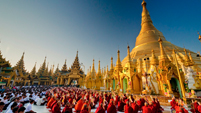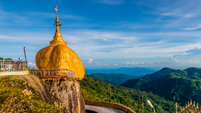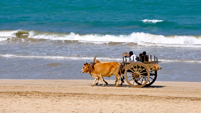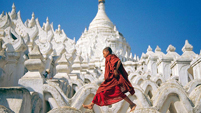- Location: In Nyaung-U, a town near Bagan, in Burma
- Status: A Buddhist temple
- Built by: King Anawrahta
- Completed: in AD 1102
- Attractions: Consisting of a circular gold leaf-gilded stupa surrounded by smaller temples and shrines
Located in Nyaung U, Shwezigon Pagoda represents the original structure for all later typical Burmese stupas. It is the most renowned Buddhist site in Bagan which expresses the close-knit connection between Theravada Buddhism and traditional Burmese religion.
Shwezigon Pagoda was first constructed in 1057 under the reign of King Anawrahta. The Emperor was among the first ones promoting Theravada Buddhism in Myanmar. Also, he was the first King who built Buddhist pagodas in Bagan. Traits of Burmese religion before Buddhism influences are shown in sculptures exhibiting the 37 nats (spirits) placed by Anawrahta on the pagoda’s lower terraces. Time after time, these figures were moved to the southeastern hall of the pagoda.
Unfortunately, Anawrahta could only finish three terraces of Shwezigon Pagoda as he died in 1077 after being attacked by a wild buffalo. Later on, King Kyanzittha, the successor of King Anawrahta, continued to build Shwezigon Pagoda and finished it in around 1090. Under his time, Bagan gradually turned to the land of four million pagodas as we know today.
The structure of Shwezigon Pagoda is a gold gilded stupa in cylindrical shape, placed on top of several terraces. It is believed to enshrine the sacred bones and teeth of Gautama Buddha. Also, there is a stone pillar with inscription in Mon language by King Kyansittha. From century to century, Shwezigon Pagoda was devastated by earthquakes, especially the mass one in 1975 which damaged Shwezigon’s terraces, dome and spire. Not until 1983 has the pagoda been gold gilded like the way we see it today.





























 Ananda Temple
Ananda Temple Bagan Archaeological Museum
Bagan Archaeological Museum Dhammayan Gyi Temple
Dhammayan Gyi Temple Dhammayazika Pagoda
Dhammayazika Pagoda Htilominlo Temple
Htilominlo Temple Kyansittha Cave Temple
Kyansittha Cave Temple Kyaukgu Umin Temple
Kyaukgu Umin Temple Maha Bodhi Phaya
Maha Bodhi Phaya Manuha Temple
Manuha Temple  Mt. Popa
Mt. Popa Myazedi Pagoda
Myazedi Pagoda Myinkaba Gubyaukgyi Temple
Myinkaba Gubyaukgyi Temple  Nan Paya Temple
Nan Paya Temple Nyaung U Market
Nyaung U Market Sa Lay
Sa Lay Shwesandaw Pagoda
Shwesandaw Pagoda  Shwezigon Paya
Shwezigon Paya Sulamani Temple
Sulamani Temple That Byin Nyu Temple
That Byin Nyu Temple  Wetkyi in Gubyaukgyi Temple
Wetkyi in Gubyaukgyi Temple













